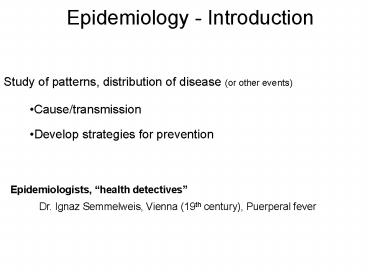Epidemiology - Introduction PowerPoint PPT Presentation
Title: Epidemiology - Introduction
1
Epidemiology - Introduction
Study of patterns, distribution of disease (or
other events)
- Cause/transmission
- Develop strategies for prevention
Epidemiologists, health detectives
Dr. Ignaz Semmelweis, Vienna (19th century),
Puerperal fever
2
Epidemiology
- Principles of Epidemiology
- Epidemiological studies
- Infectious Disease Surveillance
- Trends in Disease
- Nosocomial Infections
3
Principles of Epidemiology
- Rate of Disease in a population
- Reservoirs of Infection
- Transmission
- Influential Factors
4
Rates of Disease in a Population
Endemic - disease constantly present in a
particular geographic area
Epidemic - disease with an unusually high
occurrence
Pandemic - worldwide severe epidemic
Morbidity - illness (morbidity rate)
Rate vs. Absolute number
Mortality - death (mortality rate)
5
Outbreak cluster of cases occurring during a
brief time interval and affecting a specific
population.
6
Spread/prevention of disease
Natural habitat
Reservoir
7
Reservoirs of infectious agents
- Human reservoirs
Symptomatic
ex. cold virus
Asymptomatic carriers
ex. Neis. gon.,
Staph. aureus
humans only reservoir - easiest to control
- Non-human animal reservoirs
poultry - Salmonella, Campylobacter
8
(No Transcript)
9
Reservoirs of infectious agents
- Human reservoirs
Symptomatic
ex. cold virus
Asymptomatic carriers
ex. Neis. gon,
Staph. aureus
humans only reservoir - easiest to control
- Non-human animal reservoirs
poultry - Salmonella, Campylobacter
rodents - Yersinia pestis
bats and racoons - rabies virus
10
(No Transcript)
11
Reservoirs of infectious agents
- Human reservoirs
Symptomatic
ex. cold virus
Asymptomatic carriers
ex. Neis. gon,
Staph. aureus
humans only reservoir - easiest to control
- Non-human animal reservoirs
poultry - Salmonella, Campylobacter
rodents - Yersinia pestis
bats and racoons - rabies virus
animal reservoir - difficult to control
12
Reservoirs of infectious agents
- Human reservoirs
Symptomatic
ex. cold virus
Asymptomatic carriers
ex. Neis. gon,
Staph. aureus
humans only reservoir - easiest to control
- Non-human animal reservoirs
poultry - Salmonella, Campylobacter
rodents - Yersinia pestis
bats and racoons - rabies virus
animal reservoir - difficult to control
- diseases of animals transmitted to humans
Zoonoses/zoonotic diseases
- Environmental reservoirs
soil - Clostridium species
13
Transmission
Horizontal (person to person)
Vertical (mother to fetus)
- contact
direct contact
indirect contact
fomite
- inanimate object, such as clothing, doorknob
and so on
Importance of hand washing
droplet
Large microbe-laden respiratory droplets
generally fall to the ground on farther than 3
feet. Importance of covering mouth when cough or
sneeze
14
(No Transcript)
15
Transmission
horizontal
Transmission
Natural habitat
vertical
Reservoir
- contact
direct contact
indirect contact
fomite
- inanimate object
droplet
- food and water
- air
very difficult to control
- vectors
arthropods
flea - Yersinia pestis
mosquito - Plasmodium species (malaria)
16
Black Death (Plague) - Yersinia pestis
Killed 1/4 of the population of Europe between
1346 - 1350 75 of the population in some cities.
Bubonic plague
- Flea transmits Y. pestis to a human
- Bacterium is carried to a lymph node.
- Bubo develops within days
- Y. pestis begins interfering with the
inflammatory response - arms itself
- Multiplying bacteria spill into bloodstream
(septicemic plague) endotoxin ? shock, DIC
- 50 - 75 mortality (if untreated)
17
Influential Factors
- Dose
- There are few if any infections for which
immunity - is absolute.
- Incubation Period
- Population Characteristics
- Immunity, General Health, Age, Gender,
- Genetic Background
18
Epidemiological studies
- Descriptive studies
Risk factors
Person Place
Time
- Analytical studies
- Experimental Studies
Which risk factors were/are most relevant?
19
Epidemiological studies
- Descriptive studies
Person Place Time
Person
20
Epidemiological studies
- Descriptive studies
Person Place
Time
21
Epidemiological studies
1 2
- Descriptive studies
Person Place
Time
- Rapid rise of sick people
- Gradual rise
22
Experimental studies
Experimental studies are done mostly to assess
the value of a particular intervention or
treatment, such as antimicrobial drug therapy.
- Placebo
- Double-blind
23
(No Transcript)
24
Rates of Disease in a Population
25
Rates of Disease in a Population
26
Infectious Disease Surveillance
CDC - National Centers for Disease Control and
Prevention
MMWR - Morbidity and Mortality Weekly Report
WHO - World Health Organization Weekly
Epidemiological Record
27
(No Transcript)
28
(No Transcript)
29
(No Transcript)
30
Trends in Disease
- Reduction Eradication of Disease
- Emerging Diseases
31
Trends in Disease
- Reduction Eradication of Disease
- - Improved sanitation
- - Reservior vector control
- - Vaccination
- - Antibiotic treatment
- (Smallpox, eradicated globally)
32
Trends in Disease
- Emerging Disease
- - Microbial Evolution, drug-resistance strain
- - Population expansion
- - Mass distribution importation of food
- - Climate change
33
Nosocomial Infections(hospital-acquired
infections)5-6 patients, 4.5 billion cost
- Enterococcus species. Part of the normal
intestinal flora -
urinary, wound blood infections - Escherichia coli. Part of the normal
intestinal flora - Most common cause nosocomial urinary
infection - Pseudomonas species. Grow in moist environment
- Staphylococcus species. Normal skin flora
- Common cause of nosocomial pneumonia and
surgical site infection
34
Epidemiology
- Principles of Epidemiology
- Epidemiological studies
- Infectious Disease Surveillance
- Trends in Disease
- Nosocomial Infections
35
(No Transcript)

